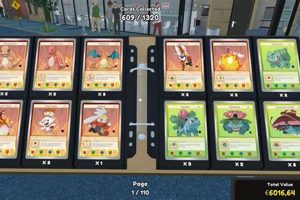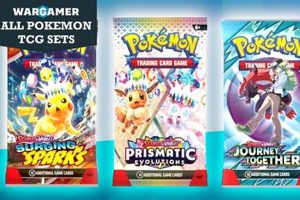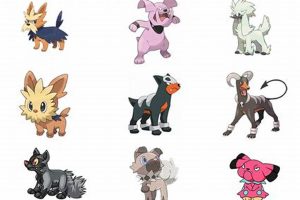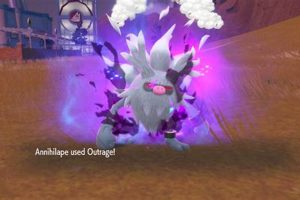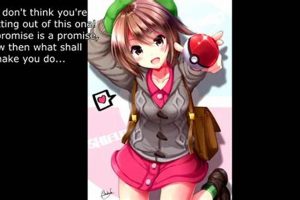The initial choices available to players at the beginning of the Game Boy Color title, Pokmon Crystal, consist of three distinct Pokmon types: Fire, Water, and Grass. These Pokmon represent the foundation upon which the player builds their team and influences the early game strategy. The Fire-type is Cyndaquil, which evolves into Quilava and then Typhlosion; the Water-type is Totodile, evolving into Croconaw and then Feraligatr; and the Grass-type is Chikorita, evolving into Bayleef and then Meganium. The selection of one prevents the player from obtaining the other two in a standard playthrough.
These choices are paramount to the initial gaming experience due to their impact on early Gym Leader battles and overall team composition. Each possesses unique strengths and weaknesses against the opposing Gym types and wild Pokmon encountered. Furthermore, the selection made by the player can shape their engagement with the game’s narrative and the difficulty experienced in the early stages. The historical significance of these Pokmon stems from their introduction during the second generation of the franchise, solidifying their legacy within the overall series.
The following sections will provide a detailed analysis of each of these options, their evolutions, move sets, and potential strategic advantages and disadvantages within the context of Pokmon Crystal. Consideration will be given to their viability throughout the entire game, including the post-game content.
Strategic Selection
The selection of an initial Pokmon in Pokmon Crystal significantly influences the early game trajectory. Careful consideration of each option is advised to optimize gameplay.
Tip 1: Addressing Type Matchups: Analyze the type advantages and disadvantages of each option against the early Gym Leaders. Chikorita presents a significant challenge against the first two Gyms, while Cyndaquil offers an advantage against Bugsy and a neutral matchup against Falkner.
Tip 2: Considering Movepools: Evaluate the learnsets of each potential choice. Totodile learns powerful Water-type moves early on, providing consistent damage output. Cyndaquil benefits from early access to Ember, offering reliable Fire-type damage.
Tip 3: Balancing Team Composition: Think about the overall team composition early in the game. Selecting a Pokmon that complements the weaknesses of common wild Pokmon is advantageous. For instance, choosing Totodile provides early coverage against Rock and Ground types often encountered.
Tip 4: Managing Resources: Understand the limited resources available during the early stages of the game. Selecting a Pokmon with reliable damage output conserves Potions and other healing items.
Tip 5: Planning for the Late Game: Consider the long-term viability of each selection. While Chikorita presents early challenges, Meganium can provide support and healing throughout the entire game, though its offensive capabilities are limited.
Tip 6: Taking Advantage of Egg Moves: Explore potential egg moves that can be passed down if planning on breeding. These can grant access to movesets not normally available, enhancing competitive advantage.
Optimal initial selection involves a thorough understanding of type matchups, movepools, resource management, and long-term viability. Balancing immediate advantages with future team composition contributes to a successful gaming experience.
The subsequent sections will examine the specific strengths and weaknesses of each individual choice in greater detail.
1. Type matchups
In Pokmon Crystal, type matchups are a fundamental consideration when selecting an initial Pokmon. The Fire, Water, and Grass types of Cyndaquil, Totodile, and Chikorita, respectively, directly influence the difficulty of early encounters. The effectiveness of each starter against the initial Gym Leaders and wild Pokmon creates a cascading effect on the player’s resources and progression. For example, choosing Chikorita, a Grass-type, presents a significant disadvantage against Falkner’s Flying-type Pokmon and Bugsy’s Bug-type team. Conversely, selecting Cyndaquil grants an advantage against Bugsy. This initial type interaction establishes the player’s need for strategic team building to overcome inherent weaknesses.
The practical significance of understanding type matchups extends beyond the immediate benefits. A player selecting Totodile, a Water-type, will have an easier time navigating the early game, but may lack coverage against Electric-type Pokmon later on. The initial selection dictates the early game narrative, shaping the player’s experiences and necessitating careful consideration of future team members to address coverage gaps. Players can use resources to determine what type they will need in the future and what coverage they are lacking due to their starter selection. This highlights the direct impact of type matchups on strategic decision-making throughout the entire game, making it a critical component when selecting a Pokmon Crystal starter.
In summary, type matchups form an inseparable link with the selection of Pokmon Crystal starters. The type advantages and disadvantages inherent in each choice influence not only the early game’s difficulty but also the long-term strategic considerations for team composition and overall gameplay. Understanding these interactions is fundamental to optimizing the player’s experience and achieving success. These matchups are only the beginning of understanding the game.
2. Evolution paths
The evolution paths of the initial Pokmon options in Pokmon Crystal are intrinsically linked to the starter selection process. Each of the three choicesCyndaquil, Totodile, and Chikoritaundergoes two stages of evolution, culminating in their final forms: Typhlosion, Feraligatr, and Meganium, respectively. These evolutions significantly alter their statistical profiles, movepools, and strategic roles within a player’s team. The inherent value of a starter choice is thus determined not only by its initial capabilities but also by the potential of its evolved forms. As an example, the initial weakness of Chikorita in the early game is mitigated by the supportive capabilities of Meganium in later stages, which can offer useful team support via moves like reflect and light screen, which can also be useful for single player playthroughs.
The practical significance of understanding these paths extends to long-term team planning. A player selecting Cyndaquil anticipates the powerful Fire-type attacks that Typhlosion will eventually access, but must also plan for its vulnerability to common Water-type attacks. Conversely, the selection of Totodile ensures a reliable Water-type attacker in Feraligatr, but might necessitate acquiring coverage against Grass-type Pokmon to balance the team. The final evolved form of each selection is pivotal, impacting the player’s ability to compete against the Elite Four and other trainers. Furthermore, breeding can play a role in determining a pokemon’s evolutions.
In summary, the evolution paths of the Pokmon Crystal starters are integral to their overall value and strategic importance. These paths dictate the Pokmon’s eventual power, move options, and role in the player’s team. The consideration of these evolutionary trajectories is essential for making informed decisions that will shape the long-term success of the player’s Pokmon Crystal experience. Ultimately, it is up to the player to decide which evolution path is best to take based on their play style and what kind of team they are building.
3. Movepool diversity
Movepool diversity, in the context of Pokmon Crystal starters, refers to the range of different attack types and utility moves a particular Pokmon can learn. This characteristic is paramount in determining the strategic viability and adaptability of a starter choice throughout the game. A broader movepool enables a Pokmon to effectively counter a wider array of opponents and adapt to various battle scenarios.
- Type Coverage and Versatility
A diverse movepool provides type coverage, allowing a starter to deal super-effective damage against multiple types of Pokmon. For instance, while Cyndaquil’s evolution line primarily learns Fire-type moves, access to moves like Earthquake or Thunder Punch can provide crucial coverage against Water, Rock, or Electric-type opponents. This versatility is essential for overcoming type disadvantages and maintaining offensive pressure.
- Strategic Utility Moves
Movepool diversity extends beyond offensive attacks to include strategic utility moves such as status ailments (e.g., paralysis, poison), stat boosts, and defensive maneuvers. A starter with access to moves like Reflect, Light Screen, or Toxic can provide valuable support to the team, increasing survivability and disrupting opponent strategies. This versatility contributes to a more well-rounded team composition.
- Adaptability to Opponent Strategies
A limited movepool can render a starter predictable and easily countered by experienced players. A diverse movepool allows for greater adaptability, providing multiple options for responding to different opponent strategies. For example, if an opponent anticipates a Fire-type attack from Typhlosion, the player can utilize an alternative move to exploit a different weakness or disrupt the opponent’s strategy.
- Long-Term Strategic Value
While early-game advantages are important, the long-term strategic value of a starter is determined by its movepool diversity in the late game. A starter that can learn a variety of powerful attacks and utility moves will remain relevant throughout the entire game, including challenging battles against the Elite Four and post-game content. This ensures that the initial starter selection continues to contribute meaningfully to the player’s success.
The movepool diversity of Pokmon Crystal starters is a critical factor in determining their strategic value and overall utility. A broad and versatile movepool provides type coverage, strategic options, and adaptability, enhancing the starter’s ability to contribute to a successful team throughout the entire game. The careful evaluation of movepool diversity is essential for making informed decisions that will shape the player’s Pokmon Crystal experience. The more moves a Pokemon can learn, the more versatile it becomes.
4. Availability
The availability of the initial Pokmon choices in Pokmon Crystal is a defining characteristic that significantly shapes the early stages of gameplay. Unlike wild Pokmon, which can be encountered and captured repeatedly, the three starters Cyndaquil, Totodile, and Chikorita are presented as a mutually exclusive choice. A player can only acquire one of these Pokmon through selection at the start of the game, making it a decision with lasting consequences for team composition and strategic options. This inherent limitation creates an immediate sense of value and permanency associated with the chosen starter, as it remains a core member of the player’s party throughout their adventure. The cause for the limited availabilty of the initial starters is that this encourages players to explore different strategies and play through the game multiple times, selecting a new starter each time.
The practical significance of this limited availability is twofold. First, it necessitates careful consideration of each starter’s strengths and weaknesses, evolution paths, and movepool diversity. Players must weigh the advantages of each option against the challenges they present, considering their long-term viability within the team. Second, the scarcity of these starters influences the player’s trading behavior. Obtaining the other two starters typically requires trading with other players who have selected them, fostering a sense of community and collaboration. The unavailability of one prevents its usage throughout the game.
In summary, the constrained availability of the Pokmon Crystal starters is a foundational element that impacts team building, strategic decision-making, and player interaction. The mutual exclusivity of these choices elevates their importance, encouraging strategic planning and facilitating community engagement through trading. The understanding of this inherent limitation is crucial for maximizing the player’s overall experience.
5. Statistical differences
The inherent statistical differences among the Pokmon Crystal starters Cyndaquil, Totodile, and Chikorita are a crucial element in determining their individual strategic value and overall suitability for different playstyles. These variances encompass base stats such as HP (hit points), Attack, Defense, Special Attack, Special Defense, and Speed. The initial stat distributions directly influence a Pokmon’s performance in battle, impacting its ability to withstand attacks, inflict damage, and outspeed opponents. For example, Chikorita’s line generally has higher defensive stats, while Cyndaquil’s excels in speed and special attack. Understanding these statistical disparities allows players to make informed decisions about which starter best aligns with their preferred combat strategies, while also making them aware that each of the pokemon has its own strengths and weaknesses.
The practical significance of these statistical differences extends beyond the early game. As the starters evolve, these stat discrepancies become more pronounced, shaping their roles within the team. Typhlosion, evolved from Cyndaquil, benefits from a high Special Attack stat, making it an effective special sweeper capable of delivering powerful Fire-type attacks. In contrast, Feraligatr, evolved from Totodile, possesses a balanced stat distribution with a focus on Attack, allowing it to function as a reliable physical attacker. Meganium, evolved from Chikorita, has comparatively lower offensive stats but higher defensive capabilities, enabling it to serve as a defensive wall capable of withstanding significant damage. These variations not only determine the types of moves each Pokemon will utilize most efficiently, but the Pokemon’s ability to function as an offensive or defensive presence within the party.
In conclusion, the statistical differences between the Pokmon Crystal starters are foundational to their individual strengths, weaknesses, and strategic applications. An understanding of these disparities is vital for making informed decisions that will optimize team composition and contribute to a successful playthrough. Balancing stat-based advantages and disadvantages, players can fully use the potential of their chosen starter, maximizing their impact throughout the entire gaming experience. The knowledge of a Pokemon’s stats, as a result, is just as important as the ability to use it during a play through.
6. Strategic impact
The strategic impact of the initial Pokmon selection in Pokmon Crystal is a multifaceted consideration extending beyond simple type matchups or immediate combat advantages. It encompasses the ripple effect the initial choice has on the entire gameplay experience, influencing team composition, resource management, and overall challenge.
- Early Game Dominance vs. Late Game Viability
The selection of a starter can significantly alter the difficulty curve. A choice like Cyndaquil may grant early-game dominance due to its effectiveness against early Gym Leaders, potentially leading to an easier start. However, its long-term viability depends on its ability to adapt to later-game challenges where Fire-type Pokmon may be less advantageous. Conversely, a starter like Chikorita, while presenting early-game challenges, may develop into a supportive team member with unique utility in later stages, but may lack the raw power to sweep entire teams. The initial selection directly influences resource allocation, as easier early battles mean fewer healing items expended and more resources available for later team development.
- Team Synergy and Coverage
The strategic impact of a starter also hinges on its synergy with the rest of the team. Selecting a Water-type starter may necessitate the inclusion of Grass- or Electric-type Pokmon to address its weakness against Grass and Electric attacks. This initial decision forces players to carefully consider the overall team composition and type coverage to ensure a balanced and resilient team. The chosen starter can dictate the direction of team development, limiting or expanding the options available to the player. It affects who the player will want to catch in the future.
- Resource Management and Opportunity Cost
Each starter requires a different level of investment in terms of TMs (Technical Machines), HMs (Hidden Machines), and stat-boosting items. A Pokmon that requires specific TMs to maximize its potential may create an opportunity cost, as those TMs could have been used on other team members. The strategic impact of a starter, therefore, involves weighing the cost of maximizing its effectiveness against the benefits it provides. For instance, investing heavily in a starter may leave other team members underpowered, creating imbalances in the team’s capabilities. Each also requires a time investment as well.
- Adaptability to Different Playstyles
Different playstyles are supported by different starter choices. An aggressive, offensive playstyle may favor the selection of a powerful attacker like Typhlosion, while a more cautious, strategic playstyle may benefit from the defensive capabilities of Meganium. The strategic impact of a starter involves aligning its strengths with the player’s preferred approach to battles. This decision not only influences the immediate battle strategies but also shapes the player’s long-term enjoyment and engagement with the game. Depending on the way you play, certain Pokemon are less desirable.
In conclusion, the strategic impact of the Pokmon Crystal starters is a holistic consideration encompassing early-game dominance, team synergy, resource management, and adaptability to different playstyles. The initial selection sets the tone for the entire gameplay experience, shaping team composition, resource allocation, and overall challenge. Understanding these multifaceted implications is crucial for making informed decisions that will maximize the player’s strategic potential and overall enjoyment of the game. In Pokemon Crystal, the first pokemon selected really matters.
Frequently Asked Questions
The following questions and answers address common inquiries regarding the selection and strategic implications of the initial Pokmon choices in Pokmon Crystal.
Question 1: What is the most effective starter choice for the early game in Pokmon Crystal?
Cyndaquil is typically regarded as the most effective starter for the early game. Its Fire-type attacks are advantageous against the first two Gym Leaders, Falkner and Bugsy, granting a significant advantage in the initial stages.
Question 2: Does the initial Pokmon selection impact the difficulty of the Elite Four?
Yes, the initial selection influences the team composition required to effectively challenge the Elite Four. Each starter necessitates different supporting Pokmon to address its weaknesses and provide balanced coverage against the Elite Four’s diverse types.
Question 3: Can the other starters be obtained in Pokmon Crystal without trading?
No, the only method of acquiring the other starters in a standard playthrough of Pokmon Crystal is through trading with other players. Without trading, it is impossible to obtain all three starters within a single game.
Question 4: Which starter has the most versatile movepool in Pokmon Crystal?
Totodile exhibits the most versatile movepool among the starters. Its evolution, Feraligatr, can learn a variety of powerful Water-type attacks as well as coverage moves like Earthquake and Ice Punch, providing greater adaptability against different opponents.
Question 5: How do the base stats of the starters compare in Pokmon Crystal?
Cyndaquil’s evolution, Typhlosion, generally has higher Special Attack and Speed stats, making it an effective special sweeper. Totodile’s evolution, Feraligatr, boasts a balanced stat distribution with a focus on Attack, allowing it to function as a reliable physical attacker. Chikorita’s evolution, Meganium, features comparatively lower offensive stats but higher defensive capabilities, enabling it to serve as a defensive wall.
Question 6: What are the Hidden Power possibilities from the starters?
Since it is not possible to breed, a player has no control over which Hidden Power Type is granted from the starter Pokemon, and should be considered a non-factor when selecting which starter to use.
The selection of a starter Pokmon involves balancing immediate advantages, long-term strategic value, and preferred playstyles. Understanding these factors is vital for an optimal playthrough.
The following section will present a structured comparison of each individual starter, outlining their strengths, weaknesses, and strategic considerations in greater detail.
Pokemon Crystal Starters
The selection of one of the three available Pokmon at the outset of Pokmon Crystal represents a critical juncture in the player’s progression. This analysis has examined the multifaceted implications of this choice, encompassing type matchups, evolution paths, movepool diversity, availability, statistical differences, and strategic impact. Each starter presents unique advantages and disadvantages, shaping the early game experience and influencing the long-term dynamics of team composition and resource management.
The informed player understands that selecting among Pokmon Crystal starters is not merely a matter of personal preference, but a decision with far-reaching consequences for gameplay strategy. Further research and experimentation are encouraged to maximize the potential of each individual choice and to adapt to the diverse challenges presented within the world of Pokmon Crystal. The knowledge and insights gained through such endeavors contribute to a more enriched and rewarding gaming experience. Careful attention to detail with your starter is important.


